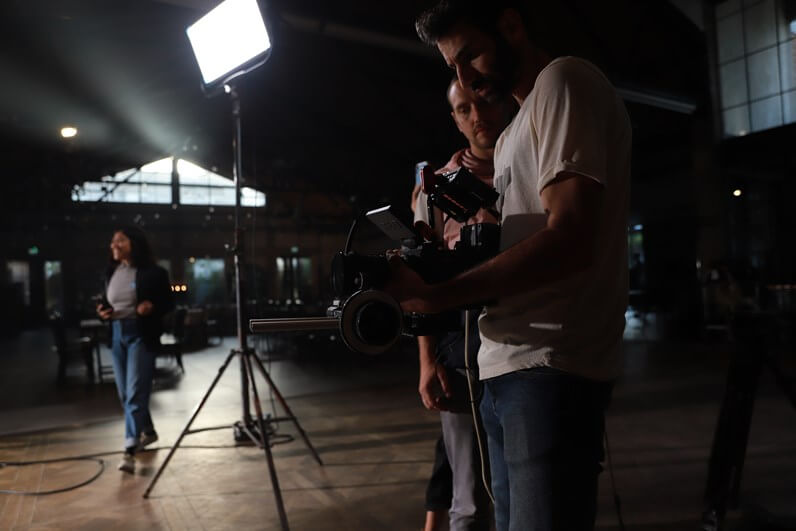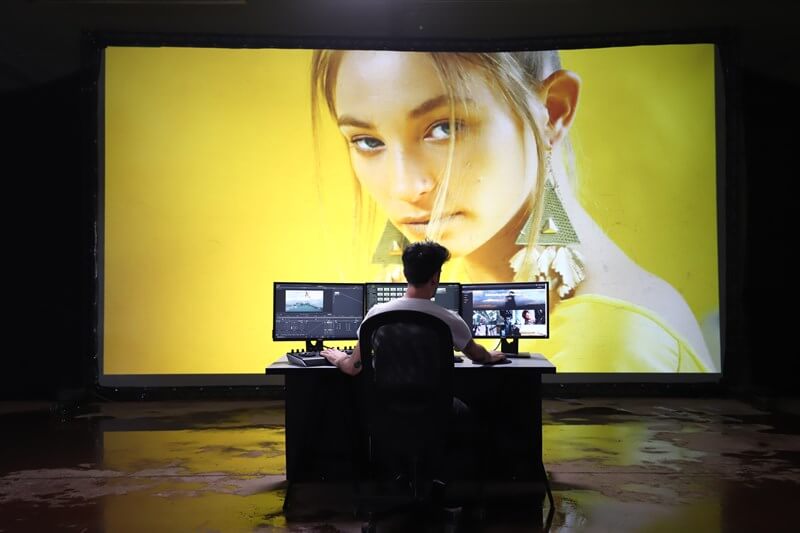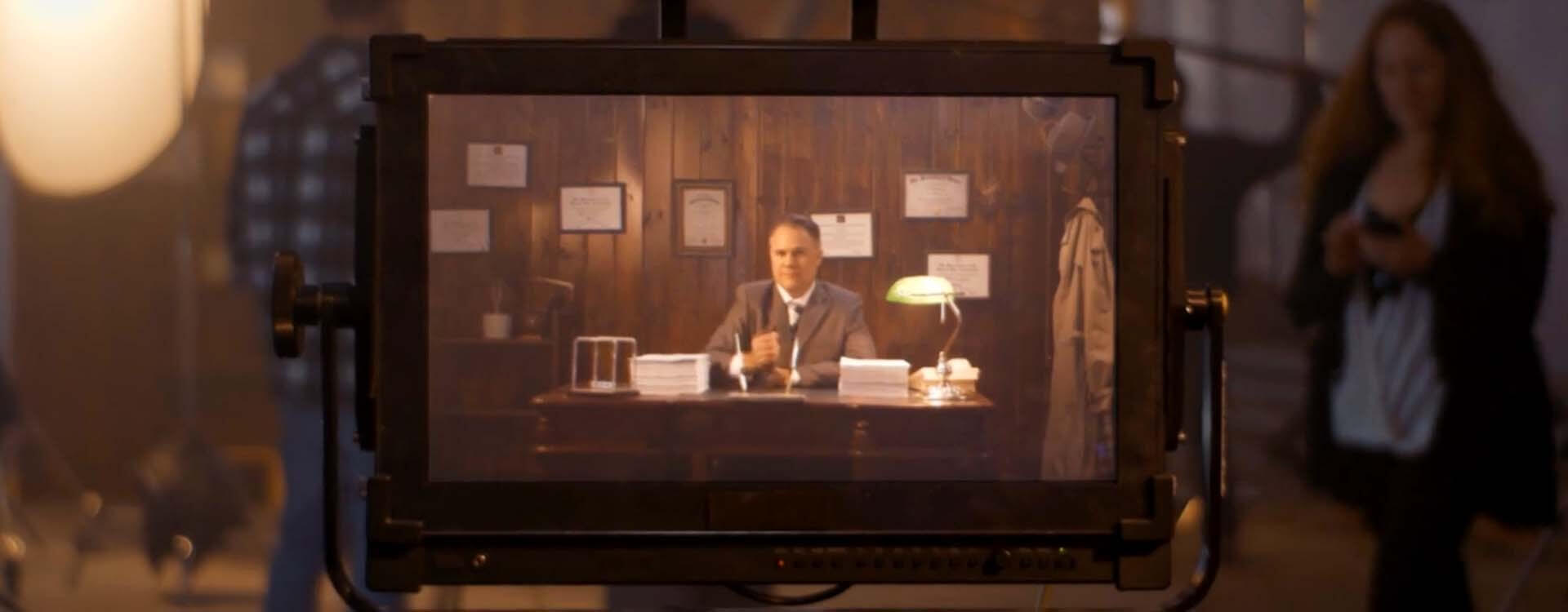Highlights
Table of Contents
Explore article topics
What is a corporate video?
It’s simple, really. Corporate videos are videos made for a business. There are many types of corporate videos and many reasons to make them, produced by small independent video production companies as well as large agencies. In addition, many companies now have an in-house videographer or entire video production team as video becomes more and more essential to a business’s success. Therefore, learning how to make videos is now a valuable skill.
Types of corporate videos
Corporate video production can take on a wide range of formats. Just look at your TV, social media, the web, news etc. Any video you see that is connected to a business or brand is essentially a corporate video. Below are some common ones.
Marketing (ads/commercials)
This may be the first type of corporate video you didn’t think of. It may be classed as a “commercial” video instead, but the line is thin and blurred. Marketing videos used to be on TV only, but now we see them all the time, everywhere, in many forms. Essentially, all corporate videos are some form of marketing for the business involved, but as we know them, ads aim to sell you a product or service. It generally starts with a problem you might have and offers a solution that their product or service is best placed to provide. Some are very creative, others to the point, often flashy. The variety is endless, and creativity could mean viral success, infamy or fading into obscurity.
Product promos/demos/launches
Product promos are often live-action, showing the product in use, sometimes in creative ways. Product demos are frequently done with a presenter explaining how the product works. This type of video details product features with text or infographics, and short versions can easily be turned into ads. Product launches may be live-streamed, which can prove challenging when things go wrong, like Elon Musk smashing the bulletproof Tesla window live on stage. It’s now commonplace to see sponsored influencer review videos shortly after a product launch providing you with their views and experience with the product pre-launch.
Testimonials & case studies
Normally, clients are interviewed about their experience with a product or service, detailing their personal or company views about how it helped them solve a problem. The videos tend to be longer format, 2 – 3 minutes or even longer. B-roll relating to or demonstrating what is being talked about is used to smooth over cuts and help illustrate the story. A compelling narrative showing how important the product or service was to solve the problem is key in keeping viewers engaged and building trust.
Business story
Similar to testimonials, these videos are often interview-based. Generally focused on the owner or originator of small businesses or the CEO of large companies. The purpose of the company video is to tell the origin story of the business, tell clients about their values and build trust in and awareness of the brand. It’s the company’s way to showcase who they are, what they do and what they stand for to raise brand awareness and build loyalty.
Social media
Most businesses have social media pages across Facebook, Instagram, Twitter and Youtube, some with very successful and popular pages. Most of these pages use video in posts or are entirely video-based. Some offer tutorials on their products, live stream discussions and launches, web conferences and more. Videos can range from raw phone clips to full high-level production with everything in between. Most run ad campaigns as well as growing organically. Social media video is part of most business marketing strategies these days.
The list goes on
There are many more examples, from corporate training videos to animated explainer videos, whiteboard videos etc.
The do’s and don’ts of corporate video production
Now let’s go over some of the things you ought to be doing and common mistakes to avoid in your corporate video production.
Pre-Production
Pre-production covers everything that happens from the first client meeting to when the images start being created. It may not be filming, as many videos may be animated, use existing material or stock footage.
Find out what your client needs
While it seems obvious, the first thing you have to establish is what your client needs vs. what they want. It is sometimes more complicated than it seems as they may not know what they want or what they need. This is particularly common with smaller businesses that are new to video. Big companies generally have an experienced marketing team that will be well-versed in what is required.
Talk budget
While you figure out what they need, you will get a sense of their expectations and what their budget is going to be. These 2 things are often misaligned, and that can lead to disappointment and problems down the line. Make sure you are clear about what is achievable within the budget they have.
Hire the right crew and talent
In some cases, it may be a one-man job, but that is rarely the best way forward with anything but the smallest productions. Even so, you never work alone as there is always at least the client as well.
The right crew can make all the difference starting with the writer of the script. The writer will take the video idea and turn it into something that can be filmed or created through animation. It’s a crucial step in the process on which all the planning and preparation are based.
Depending on what your script demands, you may need a director of photography (DP), sound recordist, gaffer for lighting, editor, animator, visual effects artist etc. Which crew you need will be entirely dependent on what you are producing and the budget. Their skill will determine your success.
If there is someone that features in your video like an actor, presenter, narrator or someone being interviewed, they are called talent. The quality of your talent can have a big impact on the end result of your video, so choose well.
Plan and prepare
There will never be enough time. Planning the production process, working with client and crew schedules and knowing precisely what needs to be done is essential. Call sheets, scripts and shot lists, storyboards, charged batteries, familiarity with equipment, skill, experience and training are all critical parts for smooth production.
Production

You know what corporate video it is you need to make. You have planned for it; you know every shot, angle, line of dialogue you need. Now it is time to start creating. It may involve animation, which is a process on its own, but it often involves filming.
Film it well
While the director brings the video to life, the DP works with the gaffer to get the lighting just right, and the sound recordist ensures crystal clear audio if there is any. If you are a one-man-band videographer, you do it all.
Don’t fix it in post
Get it right on the day, don’t leave it for someone to fix later. Take the time and get it right on camera. The results will be better.
Don’t lose media
Back up your files, then back them up 2 more times in different places. Losing media could be disastrous, resulting in expensive re-shoots and wasting everyone’s time.
Film enough b-roll
B-Roll is a blessing for the editor, so make sure to film enough relevant b-roll. A 3-minute video may need as many as 40-60 shots of b-roll depending on the pacing. Make sure to get the coverage.
Watch out for logos and copyrighted material
Corporate videos can’t have other brands’ logos in them, any copyrighted materials or unreleased talent. Keep an eye on the background for photos, logos on clothes, branded signs, and make sure any music playing is licensed.
Don’t break the rules, get permits
Commercial work, even in public spaces, will require permission. Most public spaces will need a location permit to film, especially if things like drones or a large crew are involved. Sometimes small crews may have exemptions.
Get unlimited royalty-free 4K footage
Post-Production

After filming ends, all the images need to be put together in a sequence to make the video.
Edit it to perfection
It’s sometimes amazing to see how different a video can be depending on how it is edited. So don’t settle on your first version. Instead, make a few, mull over and analyze the versions until you work out the right one.
Add a soundscape
Sound design makes all the difference; it can really draw you into a video. What you can’t capture while filming needs to be added during editing. Everything from footsteps to clothes rustling can make a real difference. Sound effects libraries like the one from Artlist are a valuable resource for royalty-free assets.
Don’t use the wrong music
Music can immensely enhance your video or be incredibly distracting. Using the right corporate video music is key. Your music also needs to be licensed, and a large royalty-free music library like the one from Artlist really helps you find the right tunes. Pay attention to the volume as well so your music doesn’t drown out other audio. Finally, you need the right mix. See this great example with Artlist.io music.
Use a style guide for graphics and titles
Keep in line with the look of the brand when using titles and graphics. Brands usually have a style guide that details the brand colors, fonts, logos and how they should be used.
Keep it moving – pacing
Pacing is vital to keep your audience engaged. It should fit with the mood of what is happening. Fast action works well with fast cutting, while an interview will generally be better with a slower pace.
Make it snappy
Attention spans are shrinking, and there is a lot of content out there to watch. Respect your viewers’ time by keeping your video short while still delivering the key message. You may need to “murder your darlings,” as the saying goes, and just keep what is essential to get the video’s message across.
Don’t forget subtitles
Besides catering to a wider audience, subtitles are key to getting your video seen. Many people watch videos without sound, especially on social media, so make sure to add subtitles to your video.
Get it seen
Making a corporate video is only the start. The client has made the investment in this great video; now, it is crucial to ensure they get it viewed to get the best value out of it. Don’t just publish and forget. The release needs a marketing strategy.
Final thoughts
Making the best corporate videos requires skill and teamwork from everyone involved. Some corporate video productions may be small, but planning, preparation, and skill are key to success regardless of size. When done well, the result can be a valuable asset for the business it is made for. If you are looking for the best creative assets including royalty-free music, sound effects, and stock videos to convey your corporation message, look no further than Artlist’s Business solutions for your business.
Johan Kok is passionate about visual story telling and loves the outdoors. He runs his own small video production business in Auckland, New Zealand doing mostly corporate and event work. When he has time he gets involved in local short films and other productions as well as running a small outdoor YouTube channel on the side.
Share this article
Did you find this article useful?
Related Posts
- By Robert Hardy
- 12 MIN READ
- By Jose Prada
- 7 MIN READ
Latest Posts
- 25 Apr
- By Josh Edwards
- 4 MIN READ
